Scientific Clarification
The following are the crop details for Rice:
- Scientific name: Oryza sativa
- Local names: Mchele(husked rice), Mpunga (upland rice)- Swahili
- Order: Cyperales
- Family: Poaceae
- Genus: Oryza

Rice growing terraces in the Philippines

Mature Asian rice panicles

Rice terraces in Vietnam

Asian rice field

Asian rice with panicles

Asian "basmati" rice`
General Information
There are two species of cultivated rice in the world, Oryza sativa (Asian rice) and Oryza glaberrima (African rice). Both species are annual grasses (except in the tropics, where the plant can be perennial) that are cultivated for their grain which is considered a staple food in most parts of the world.
Asian and African rice plants are morphologically very similar and can be difficult to tell apart. They have rounded stems (called culms) which are divided into nodes and internodes. The plant leaves are borne on the nodes of the stem and are long and slender with a pronounced midrib.
The plant produces three flowers, two of which are reduced, on a spikelet on the terminal (last) internode of the stem. The rice grain is formed by the ripened ovary of the flower and is between 5 and 12 mm in length. Rice is an annual plant, harvested after one growing season, and can reach a height of between 1 and 1.8 m (3.3– 5.9 ft) depending on the variety.
Rice is grown in four ecosystems, which are broadly defined based on water regimes. The ecosystems are irrigated rain-fed lowland and upland, and flood-prone.
Generally, African rice tends to form smaller, pear-shaped grains with red bran and olive to black seed coat and has several disadvantages compared with its Asian counterpart e.g. seed is easily scattered, the grain is difficult to mill and the crop gives a lower yield. The growing of Asian rice has therefore begun to supersede that of African rice in West Africa. Asian rice originates from China and African rice is believed to have been domesticated in areas around the Niger River in Africa.
Rice Varieties in Kenya
"Sindano", highly susceptible to Rice Yellow Mottle Virus (RYMV), and "Basmati 217", highly susceptible to blast, have been grown since the 1960s.
- Basmati 217: Grain yield 4.6 t/ha; very good cooking quality; resistant to RYMW and susceptible to blast.
- Basmati 370: Grain yield of 5.3 t/ha; very good cooking quality; resistant to RYMW and susceptible to blast.
- IR 2035-25-2: Grain yield of 5.5 t/ha; good cooking quality; moderately susceptible to RYMW and moderately resistant to blast.
- IR 2793-80-1: Grain yield of 6.4 t/ha; good cooking quality; susceptible to RYMW.
- BW 96: Grain yield of 9.0 t/ha; fair cooking quality; susceptible to RYMW and moderately resistant to blast.
- UP 254: Grain yield of 6.4 t/ha; good cooking quality; moderately susceptible to RYMW and moderately resistant to blast.
- AD 9246: Grain yield of 5.1 t/ha; good cooking quality; moderately resistant to RYMW and moderately susceptible to blast.
- IR 19090: Grain yield of 5.8 t/ha; good cooking quality; moderately susceptible to RYMW and moderately resistant to blast.
The upland "NERICA" rice varieties were developed at the Africa Rice Center (AfricaRice) ex-WARDA. They are resistant to blast, RYMV stemborers, and leafminers and are high yielding and doing well from West Africa to Uganda.
In Kenya, they have great potential for medium altitudes with high rainfall or the possibility for irrigation. "NERICA" can be planted as other small grains, but does need irrigation, especially during flowering, and fertilization.
Varieties in Tanzania
- Supa: Optimal production altitude: 0-400 m; grain yield: 1.5-3.5 t/ha; moderately resistant to RYMV and sheath rot.
- IR 54: Optimal production altitude: 400-600 m; grain yield: 4.0-7.0 t/ha; moderately resistant to bacterial blight and sheath rot.
- IR 22: Optimal production altitude: 400-1000 m; grain yield: 6.6-8.0 t/ha; days to maturity: 120-13"5; resistant to bacterial blight.
- Katrin: Optimal production altitude: 400-1000 m; grain yield: 6.6-8.0 t/ha; very low panicle shattering.
- Dakawa: Optimal production altitude: 400-1000 m; grain yield: 3.5-5.2 t/ha; none-photoperiod sensitive; resistant to lodging except under high N levels; easy to thresh.
- TXD 85: Optimal production altitude: 0-400 m; grain yield: 4.8-7.0 t/ha; moderately resistant to sheath rot, blast, and RYMV.
- TXD 88: Optimal production altitude: 0-400 m; grain yield: 2.8-6.5 t/ha; moderately resistant to sheath rot, blast, and RYMV.
- SARO 5: Optimal production altitude: 0-600 m; grain yield: 4.0-6.5 t/ha; susceptible to RYMV and sheath rot. Adapted to rain-fed lowlands and irrigated ecosystems.
- Kalalu: Grain yield: 2-3 t/ha; resistant to RYMV and blast.
- Mwangaza: Grain yield: 2-3 t/ha; resistant to RYMV and blast.
Climate Conditions, Soil, and Water Management
Rice thrives on land that is water saturated or even submerged during part or all of its growth. Optimal temperatures for rice growing are 20 to 37.7°C, and no growth occurs below 10ºC. The optimal pH is between 5 and 7, though rice has been grown in fields with a PH between 3 and 10. Rice will grow in altitudes ranging from 0 to 2500 m above sea level but worldwide is mostly grown on the humid coastal lowlands and deltas. Aquatic rice may require a dependable supply of fresh, slowly moving water, at a temperature of 21 to 29°C. Rain-fed rice requires an average of 800 to 2000 mm of rainfall well distributed over the growing season. If rainfall is less than 1250 mm annually, irrigation is used to make up the deficit. The crop is salt tolerant at some stages of growth; during germination but not seedling stages and has even been grown to reclaim salty soils. Terrain should be level enough to permit flooding, yet sloped enough to drain readily. The soils on which rice can grow are as varied as the climatic regime it tolerates, but ideally, it prefers a friable loam overlying heavy clay, as in many coastal and delta areas.

Zinc deficiency (2)

Zinc deficiency (1)

Nitrogen deficiency (2)

Plants showing Phosphorous deficiency

Symptoms of potassium deficiency (3)

Nitrogen deficiency

Symptoms of potassium deficiency (2)

Symptoms of potassium deficiency

Severe calcium deficit leaves
Planting Procedure
Rice is always propagated by seed, which may be either broadcast or drilled directly in the field, or the seedlings may be grown in nurseries and transplanted. Direct seeding is done in dry or puddled soil. In puddled soil, the (pre-germinated) seeds are broadcast. The water level is kept at 0-5 cm under tropical conditions, but higher in temperate areas.
In dry soil, the seeds are sown after land preparation and covered lightly with soil by a tooth harrow. Germination occurs after heavy continuous rains. In upland rice cultivation the land is prepared in the dry weather and the rice is broadcast or dibbled in with the advent of the rains. Floating rice is cultivated in areas subject to deep flooding and the seed is sown either dry or wet.
Seedling production
The following are steps for producing healthy seedlings:
- Seed selection: Select plump and healthy seeds.
- Seed pre-treatment: This is practiced to secure better germination of seeds and better growth of seedlings. It involves:
- Seed disinfection: Hot water treatment is effective in destroying the nematode Aphelenchoides besseyi, which causes white tip disease.
- Seed soaking: To supply the required moisture for germination, shorten the germination period and reduce seed rotting. During the soaking period change water to remove poisonous substances and allow entry of fresh air.
- Pre-sprouting: The seeds are drained and covered with grass for 24 to 48 hours. This ensures uniform seed germination, avoids sprouting, and allows air circulation for germination.
- Sowing: Sowing 80 to 100 g/m² is normal practice. Broadcast seed uniformly. Do not submerge the nursery bed after sowing. Use a seed rate of about 20 kg/acre (50 kg/ha).
- Seedbed preparation (nursery): Plough at least 2 weeks before sowing and flooding. Puddle 1 week before sowing and prepare a raised nursery bed. Drain the nursery bed the day before sowing to stabilize the surface of the soil. If the soil covering the nursery bed is too soft, sown grains are buried in the soil resulting in a poor establishment. For 1 ha of transplanted rice, a nursery of about 350 m² is required. Irrigate a few days after sowing so that the surface is kept moist, and as the seedlings emerge keep submerged conditions with water controlled at 1 to 3 cm according to the growth of the seedling. Raise the water level to 10 cm one day before uprooting to ease the washing off of soil that sticks to roots. This will make transplanting easy.
Land Preparation
Preparation of land varies, even within the lowland rainfed-rice areas. Land can be prepared in the following ways:
- Wetland tillage: This method is common in most tropical Asian countries. It consists of land soaking, in which water is absorbed until the soil is saturated. Ploughing, which is the initial breaking and turning over of the soil to a depth of 10-20 cm, is done using a wooden or light iron plough drawn by 1-2 buffaloes or oxen, preferably when there is 7.5-10 cm of water on the land and harrowing during which big clods of soil are broken and puddled with water. Puddling is important because it reduces moisture loss by percolation, better weed control, and ease of transplanting. The low redox potential of submerged puddled soil helps to conserve water-soluble nutrients, favors the accumulation of ammonium, increases biological nitrogen fixation, and increases the availability of phosphorus, silicon, iron, and manganese.
- Dryland tillage: The land is prepared in the dry weather and the rice is sown just before the rains begin. This method makes it possible to have initial crop growth from early monsoon rains. Labor requirements for seed-bed preparation, land preparation, and transplanting are reduced and soil structure is better for stand establishment of the following non-rice crop. This method has its disadvantages: weed control is a major problem; percolation losses are high, making the chances of drought stress higher; and fertilizer requirements are often higher. To hold the water on the land and maintain it at the required depth, bunding and leveling are essential. The land is divided by contour bunds into fields, the size and shape of which vary with the topography. The bunds are usually made of clay, mud, and weeds, with controlled openings for the ingress and egress of water.
Common Pests and Diseases
Diseases
Category : Bacterial
Bacterial leaf streak
Xanthomonas oryzae
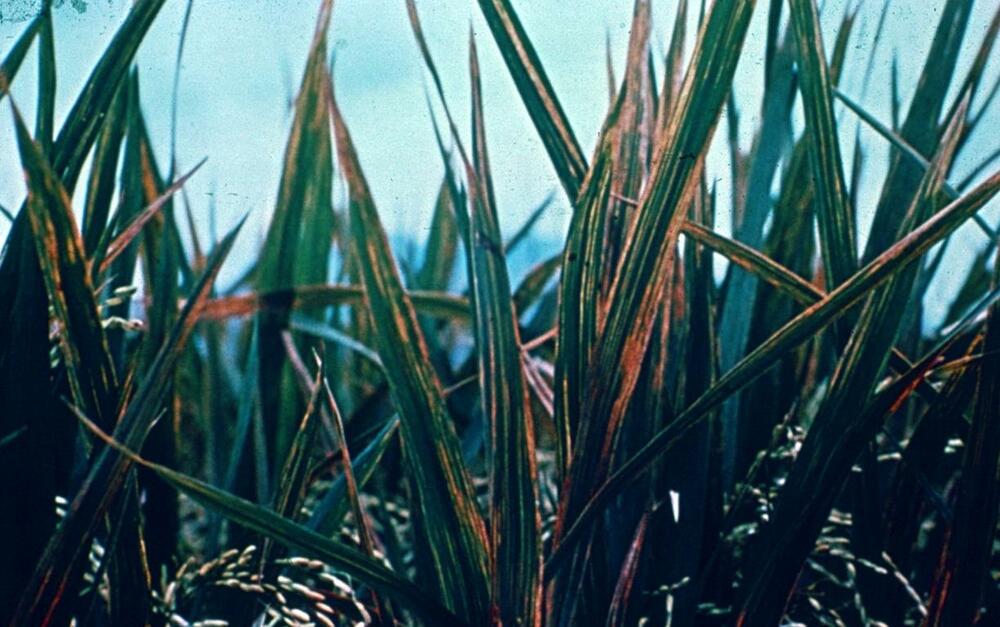
Advanced leaf streak symptoms in rice field
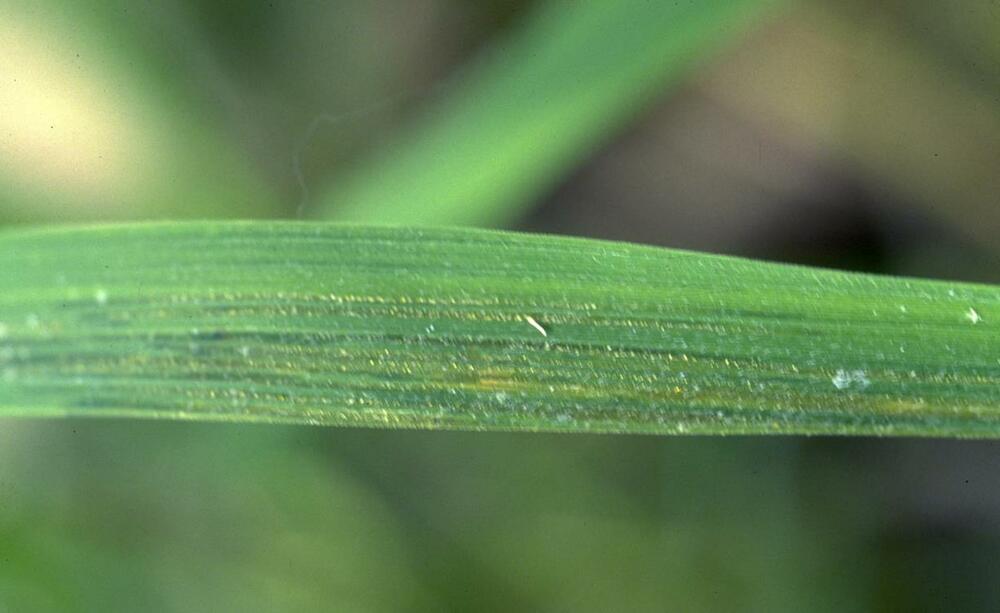
Initial symptoms of bacterial leaf streak on rice
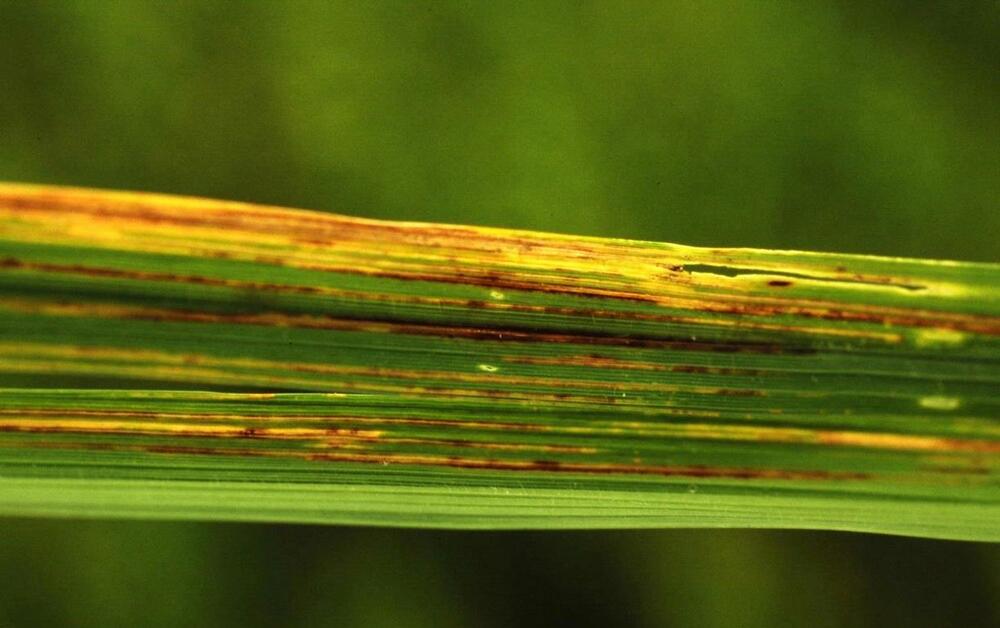
Bacterial leaf streak

Severely infected rice leaf
Symptoms
Small, water-soaked streaks between leaf veins which are initially dark green and then turn translucent; streaks grow larger, coalesce and turn light brown in color; tiny beads of yellow colored bacterial exudate are common on the surface of the streaks; leaves turn brown and then gray-white in color before they die
Cause
Bacterium
Comments
Management
Control of bacterial leaf streak is dependent on the use of resistant rice varieties and on planting of treated seed
Leaf scald
Microdochium oryzae
Symptoms
As name suggest we will see scalded appearance on leaves. The lesion is marked with different zone from alternating light tan and dark brown from leaf tips or edges. As the leaves mature the lesion is with light brown halos. Margins and leaf tips are translucent.
Cause
Fungus
Comments
Management
Grow resistant varieties. Treat the seeds with suitable fungicide. Apply only recommended quantity of nitrogen fertilizer in split dose.
Rice Bacterial blight
Xanthomonas oryzae pv. oryzae

Bacterial blight infected leaf

Bacterial blight infected field
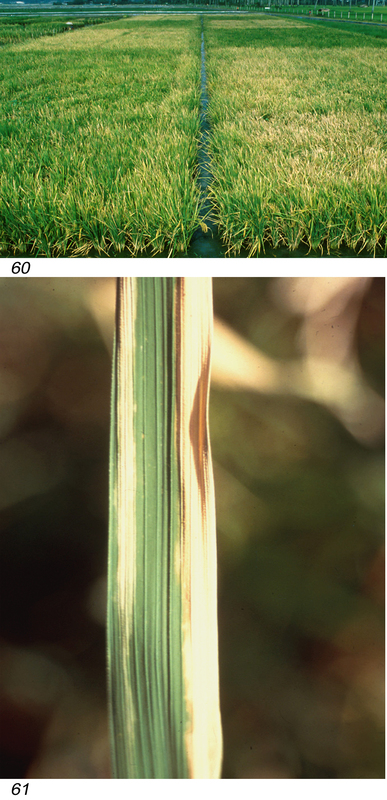
Bacterial leaf blight infected field and leaf

Bacterial blight infected leaves
Symptoms
Water-soaked stripes on leaf blades; yellow or white stripes on leaf blades; leaves appear grayish in color; plants wilting and rolling up; leaves turning yellow; stunted plants; plant death; youngest leaf on plant turning yellow
Cause
Comments
Management
Bacterial blight can be effectively controlled by planting resistant rice varieties; avoid excessive nitrogen fertilization; plow stubble and straw into soil after harvest
Category : Fungal
Bakanae
Fusarium moniliforme

Bakanae infected plant in rice field
Symptoms
Seedlings are elongated, slender and pale; seedlings are stunted and chlorotic; death of seedlings; abnormal elongation of older plants which often makes them visible as they grow taller than uninfected plants in the field; sterile plants which do not produce panicles or produce empty panicles
Cause
Fungus
Comments
Management
Treating seeds with appropriate fungicides prior to planting can be very effective at controlling the disease; less susceptible rice varieties should be grown in areas where fungicide-treated seed is not available
Brown spot
Cochliobolus miyabeanus
Symptoms
Circular, brown lesions on seedling; distorted primary and/or secondary leaves on seedlings; black discoloration of roots; death of seedlings; circular or oval lesions with gray center and reddish-brown margin on older plants; death of large areas of leaves; brown or black spots on grain; reduced number of grains; reduced kernel weight
Cause
Fungus
Comments
Management
Ensure plants are provided with correct nutrients and avoid water stress; chemical seed treatments are effective at reducing the incidence of the disease
False smut
Ustilaginoidea virens
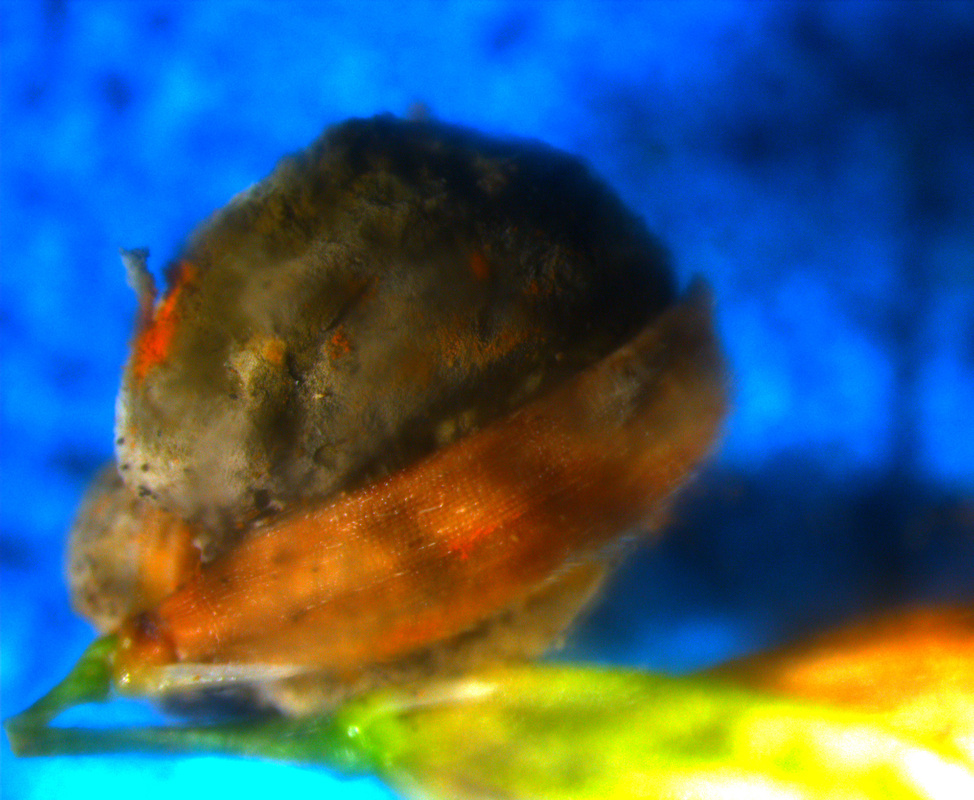
Individual grain transformed into smut
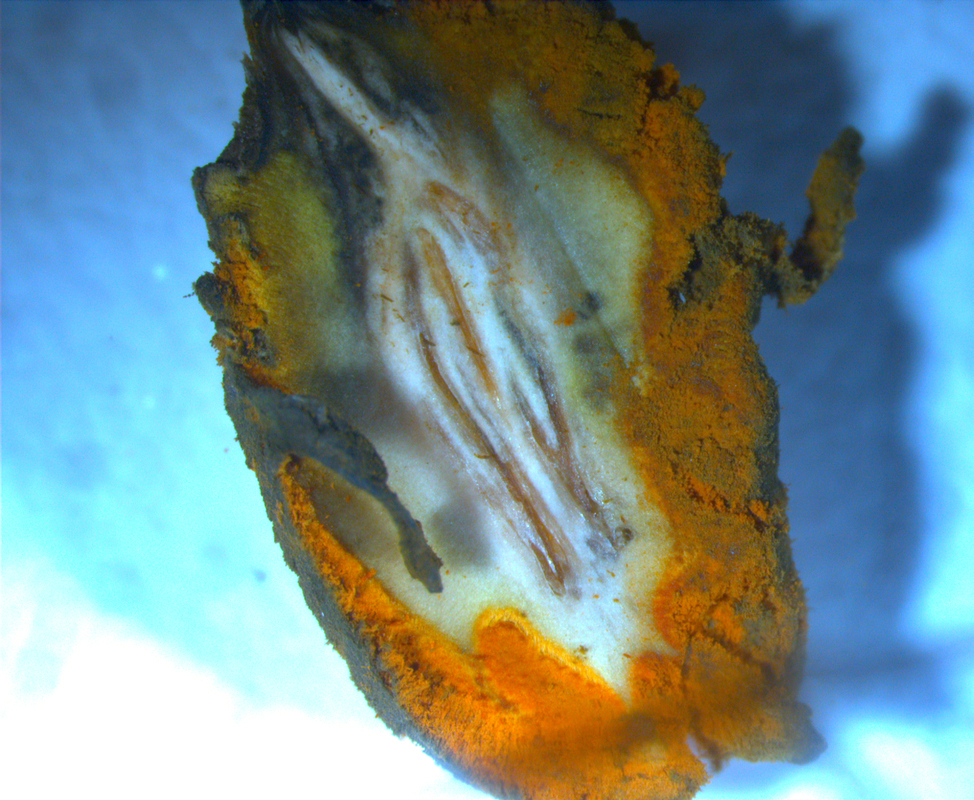
Cross-section of individual smut grain

False Smut
Symptoms
The pathogen infect the rice plant during flowering stage and causes chalkiness of grain. The individual grains were covered with orange fungal mass in the beginning, later turns into greenish velvet color during sporulation stage and finally into charcoal black during spore maturation stage. It infect only few grains in spikelet. Recorded disease loss up to 75% in severe incidence. It also reduces market value of rice.
Cause
Fungus
Comments
Management
Treat seeds with hot water (52 C) for 10 min. Roughing the infected plants from field and from harvested grains. Keep the rice field and surrounding clean. Use resistant varieties. Maintain humidity in field by alternate wetting and drying.
Narrow leaf spot (Cercospora leaf spot)
Cercospora oryzae

Narrow brown leaf spot infected leaves
Symptoms
Short, elliptical or linear brown lesions on leaves; necrosis of leaves; blotchy pattern on leaves; premature ripening of kernels
Cause
Fungus
Comments
Management
There are no chemical controls currently recommended for the treatment of the disease; treating seeds with hot water or appropriate fungicides prior to planting can reduce the incidence of the disease
Rice blast
Magnaporthe grisea

Rice blast

Blast symptoms

Blast symptoms
Symptoms
Lesions on all parts of shoot; white to green or gray diamond-shaped lesions with dark green borders; death of leaf blades; black necrotic patches on culm; rotting panicles
Cause
Fungus
Comments
Management
If disease is not endemic to the region, blast can be controlled by planting resistant rice varieties; avoid over-fertilizing crop with nitrogen as this increases the plant's susceptibility to the disease; utilize good water management to ensure plants do not suffer from drought stress; disease can be effectively controlled by the application of appropriate systemic fungicides, where available
Sheath blight
Rhizoctonia solani

Sheath blight symptoms

Water-soaked initial sheath blight lesion

Lesion on rice leaf sheath
Symptoms
Circular, oblong or elliptical, green to gray water-soaked spots on leaf sheaths; lesions with pale green or white center and purple-brown margin; lesions covering leaf sheaths and stems; poorly filled grains
Cause
Fungus
Comments
Management
Avoid overfertilizing plants as excessive nitrogen application has been shown to increase susceptibility to the disease; applications of foliar fungicides may be required; two applications are recommended and should be timed so that the first application is made between the early internode elongation and the second application made on emerging panicles 10-14 days later
Stem rot
Magnaporthe salvinii

Stem rot infected plants
Symptoms
Symptoms generally begin to appear after the mid tillering stage; black lesions appear on outer leaf sheath at the water-line; lesions expand and begin to infect inner leaf sheaths and culm begins to rot; infections which reach the culm can leaf to lodging of plants, unfilled panicles and death of tillers
Cause
Fungus
Comments
Management
Bury crop residue deeply in the soil after harvest; avoid excessive nitrogen fertilization; plant less susceptible rice varieties
Category : Viral
Grassy stunt
Rice grassy stunt virus (RGSV)
Symptoms
Stunted plants; short, narrow pale green or yellow leaves; mottled or striped pattern on newly unfolded leaves; irregular dark brown spots on leaves; few or no panicles produced;
Cause
Virus
Comments
Management
Several varieties of rice resistant to the leaf hopper vectors have been developed but the insects have overcome the resistance in several countries; applications of appropriate insecticides can help to reduce populations of vectors in temperate regions
Tungro
Rice tungro bacilliform virus (RTBV)

Tungro virus infected field

Tungro virus infected leaves
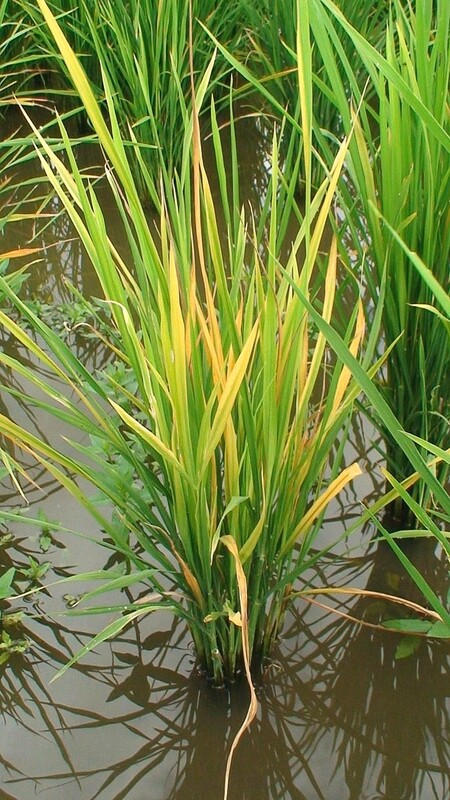
Tungro virus infected plant
Symptoms
Plants are stunted with a yellow-orange discoloration; plants may have a reduced number of tillers and rust colored spots on leaves; leaves may be mottled, striped or exhibit interveinal necrosis
Cause
Virus
Comments
Management
Rice varieties resistant to tungro virus have been developed and control the disease successfully; intense cultivation has led to the breakdown of the resistance by some virulent leafhopper strains; in Indonesia, the disease is successfully controlled by scheduling planting to obtain synchronous development and practicing crop rotation with resistant varieties
Pests
Category : Insects
Leafhoppers & planthoppers
Nephotettix spp.
Recilia dorsalis
Nilaparvata lugens
Laodelphax striatellus
Sogatella furcifera

Green Leafhoppers 1. Nephotettix virescens 2. Nephotettix nigropictus 3. Nephotettix malayanus Ishihara
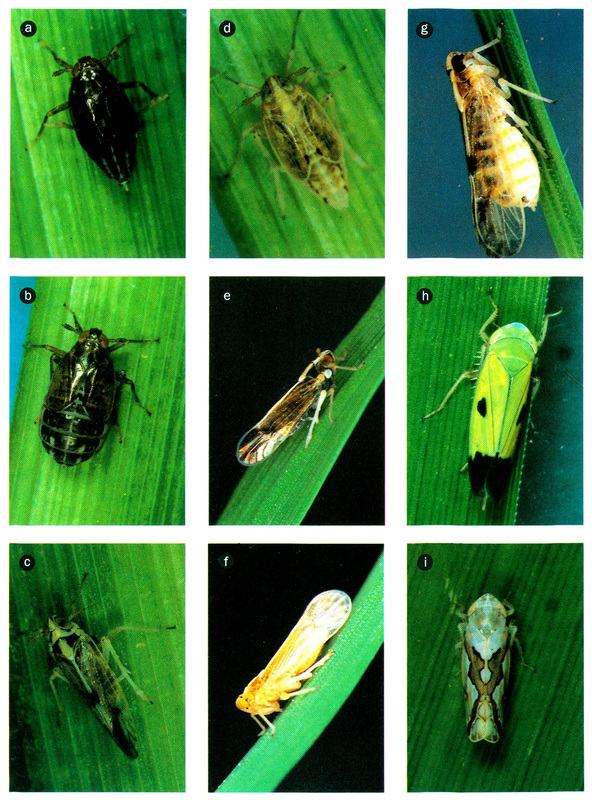
a) Nilaparvata lugens male, b) Nilaparvata lugens female, c) Sogatella furcifera male, d) S. furcifera female, e) Tagosodes orizicolus male, f) T. orizicolus female,
g) T. cubanus, h) Nephotettix virescens, i) Recilia dorsalis.
Symptoms
Plants may show no symptoms of leafhopper of planthopper damage; feeding punctures can leave the plants susceptible to bacterial or fungal infections; insects transmit many rice viruses; if infestations is severe, insects may cause plant to completely dry out; adults insects are pale green or brown winged insects with piercing-sucking mouthparts
Cause
Insect
Comments
Management
Rotating crop for a period of one year is an effective and economical method of controlling hopper numbers; natural enemies and predators are often very successful at controlling hoppers and should be conserved by avoiding inappropriate use of insecticides which can damage their populations; planting resistant varieties is a very effective control method; chemical control with an appropriate insecticide may be necessary but should only be applied if the insects have reached an economic threshold
Mole cricket
Gryllotalpa orientalis
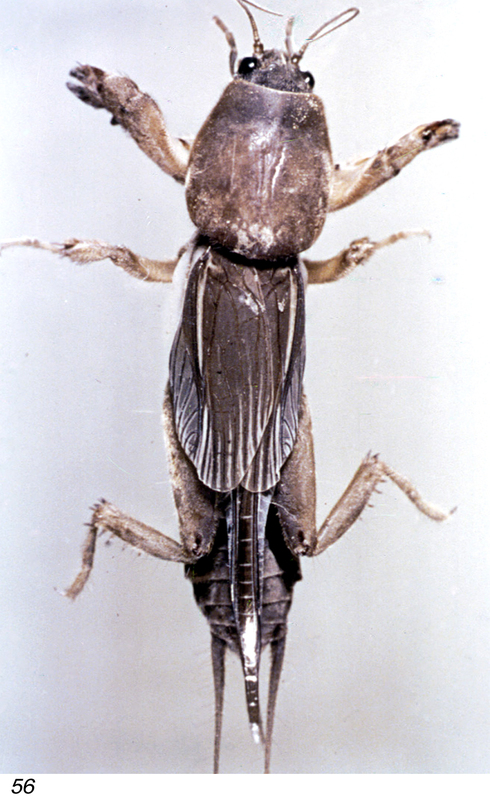
Mole cricket
Symptoms
The insect is very destructive because it feeds on seeds, tillers of mature plants and roots. It mainly cut the tillers at ground level and causes gap in rice field. Usually the symptoms appear in patches.
Cause
Insect
Comments
Management
Use resistant varieties. Level the field properly and irrigate every 3-4 days after planting. Collect and kill the insects during land preparation. Avoid nurseries with raised bed to reduce cricket infestation during seedling stage. Improve biocontrol agents in field. If damage is large use food bait (commonly rice bran) mixed with insecticide and place along borders.
Rice bug
Leptocorisa oratorius F. and Leptocorisa acuta Thunberg

Rice bug infested grains
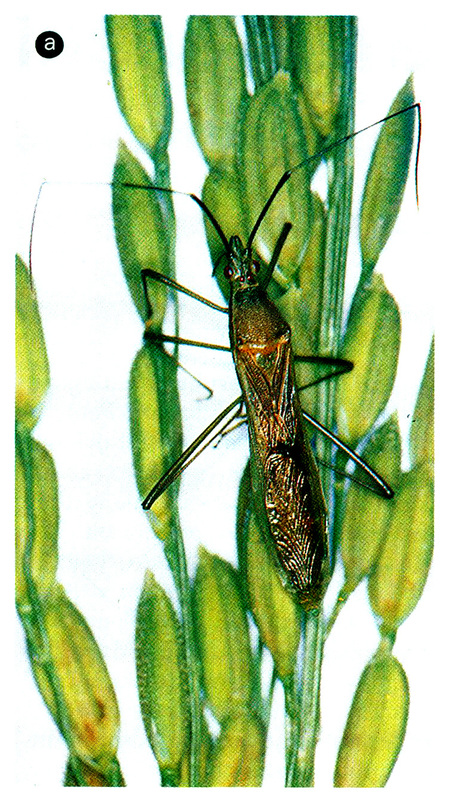
Rice bug attacking spikelet
Symptoms
The insect attacks during spikelet stage of rice crop. Both nymphs and adults suck the content out of grains from pre-flowering spikelets to soft dough stage. This leads to unfilled, empty and discolored grains.
Cause
Insect
Comments
Management
Keep the field and surrounding area free from weeds which serves as alternative host for insect during non cropping season. Equal distribution of fertilizers and water in rice field to encourage even crop growth. Collect and kill insects manually by using net during early morning and late after noon. Encourage biological control agents.
Rice case worm
Paraponyx stagnalis Stagnalis (Lepidoptera : Pyralidae)
Nymphula depunctalis (Guenee)

Rice caseworm
Nymphula depunctalis (Guenee)
Symptoms
Case worm larvae scraps chlorophyll from leaves. Another important symptom is the larvae cuts off leaf tips and make cylindrical tubes around them. In infected field you can see cylindrical tubes attached to plants or floating on water surface.
Cause
Insect
Comments
Management
Drain water to remove floating larvae from field. Follow proper cultivation practices like nitrogen application and spacing. Encourage biological control agents like snails, spiders, lady bird beetles, dragon flies in rice field.
Rice gall midge
Orseolia oryzae

Asian rice gall midge adult and eggs
Symptoms
Gall midge maggot bore into bud or stalk of rice plant and feeds on internal content which leads to formation of tubular gall at the base of the tillers. This leads to elongation of leaf sheath which is commonly called as silver shoot or onion shoot. The leaves will be wilted, deformed and curled up.
Cause
Insect
Comments
Management
Grow available gall midge resistant cultivars. Follow proper cultural practices like crop rotation, ploughing the ratoon crop and other alternative hosts, planting early etc. Use light traps to attract adult flies and kill them. Conserve biocontrol agents in rice field.
Rice mealy bugs
Brevennia rehi
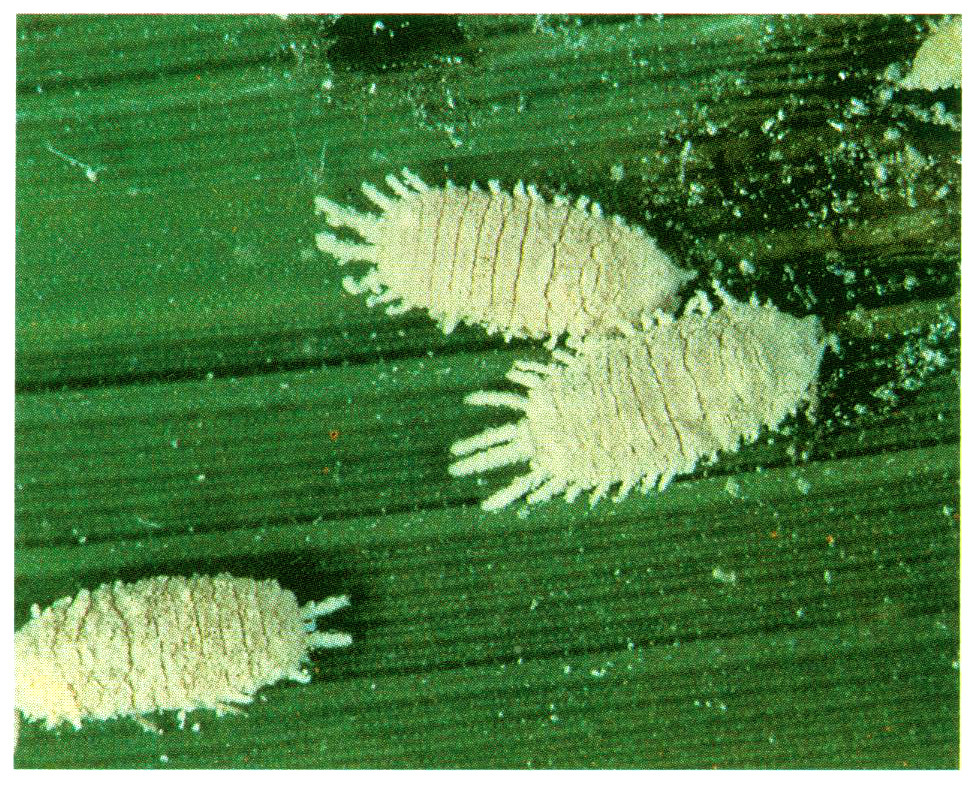
Rice mealy bugs
Symptoms
Both adult and nymphs feed on rice plant by sucking sap. The main symptoms are stunting and wilting of plants, yellowing and curling of leaves.
Cause
Insect
Comments
Management
Augment biocontrol agents (like lady bird beetles, chloropid flies, spiders, small encyrtid wasps) in rice fields.
Stem borers (Yellow stem borer, Striped stem borer, White stem borer, etc.)
Scirpophaga incertulas
Chilo suppressalis
Scirpophaga innotata

Stem borers symptom: 'deadheart' in seedling stage (12) and 'whitehead' after flowering (13)

Adult rice stem borers

Damage caused by stem borers: b) whitehead.

Yellow stemborer: Scirpophaga incertulas
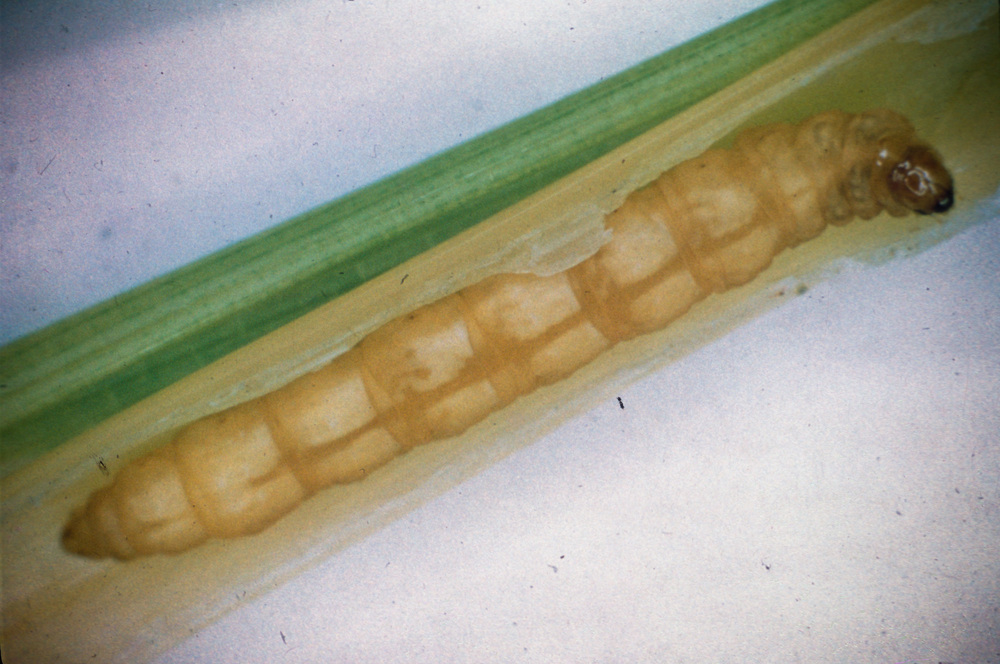
Rice stem borer
Symptoms
Longitudinal white patches on leaf sheaths; central leaf whorl drying out and turning brown; tillers drying out without producing panicles; panicles may dry out or may produce no grain; adult insects are nocturnal moths which lay their eggs on the leaves or leaf sheaths of the rice plants; larvae are legless grubs which feed on leaf sheaths before entering the stem of the pant
Cause
Insect
Comments
Management
Stem borers are difficult to control with insecticides as once they bore inside the stem they are protected from chemical sprays; in order for chemical control to be successful, repeated applications of appropriate insecticide must be made to the foliage; granular formulations give better control than sprays; clipping seedling prior to transplanting can successfully reduce moth numbers as eggs are laid at leaf tips; harvesting plants at ground level can remove the majority of larvae from the field; plowing or flooding the remaining stubble will kill off most of the remainder of the larvae in the field



















































